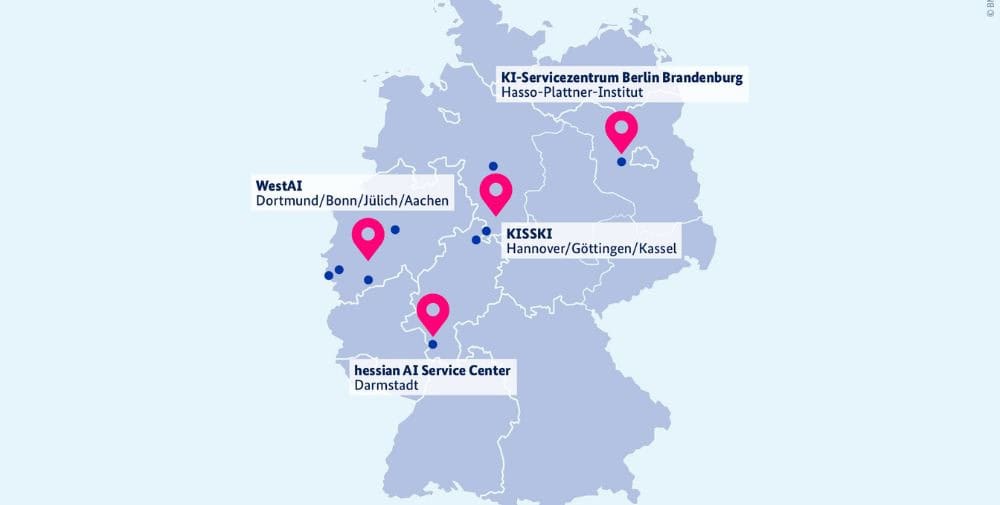Open source models were like a revolution, Microsoft came out of hell for the developer community and Linux was hailed as the saviour. Suddenly there was only one choice: For or against open source.
Today, the digital industry is much more complex when it comes to business models. In this keynote speech, which has become a text, we will leave out the project and service business. As we all know, this scales like the tablets of stone in Moses’ proclamation of the 10 commandments. So nothing for business developers.
Today, however, there is an essential factor that hardly anyone wants to hear about: artificial intelligence, in our case large language models (LLMs), which will change an as yet unimagined part of the business model world. However, and this is the good news for all those who are only superficially familiar with the thicket of business models: Experts do not expect new business models but hybrid and highly personalized models.
It is precisely because competition has become louder and stronger in every industry that there is a great opportunity for differentiation in offering clever business models based around software components or solutions and types of use.
As a business model designer, anyone who wants to build or expand their business model around enterprise software should first look at the past and understand where these new, “fancy” models actually come from. A few comparisons will help with classification.
Just as every generation is characterized by cultural highlights such as music styles and social changes, this is also the case with software models. The further we look back, the further we can look forward, draw parallels and find approaches to business model design.
The Glam Rock Era: Licensed Business Models (1980s)
In the hope that some of you have already experienced this phase: It was actually the starting shot in which software went from being a service to a real product. Licenses made it possible to retain intellectual property and sell copies to multiple customers with high profit margins. Even then, the profit margin was above 80%.
Famous code keys were used for enterprises and consumers. These unlocked the software and could be redistributed at will. Anyone could do anything with the software.
Grunge & Rave: Perpetual License (late 1980s to 1990s)
Introduction of perpetual licenses combined with support and maintenance fees. These licenses were basically costs that were paid in advance at the time. On top, there were 20 to 30 % fees for maintenance. This led to good margins of over 90%!
Open source is the hip hop business model of the late 1990s. The trend continues to this day and is also being embraced by Microsoft.
The licenses for the use and modification of open source software are free. In principle, it is about releasing the code and involving a community of developers in its further development. People work together and discuss in order to constantly improve the software. Just like in hip hop, we sample and create new branches and applications. Open source is the ultimate democratization in the software industry!
While the basis is provided free of charge for the community, agencies, software forges and start-ups make their business with premium applications, maintenance, security, managed services or certifications. And they earn significantly more than the open source developers, who are more committed to democratization.
Open source is omnipresent today in connection with Linux. Perhaps not in the way that was assumed at the time, but there is hardly an area of IT in which open source is not quietly and reliably doing its job at some point.
Mashup: Hybrid Open Source (2000s)
Combination of a paid software product and a free open source project. Business models are created around fees for support and maintenance. Software scaling is also a popular model to this day.
The era of “Spotify’isation”, the influence of the cloud and significantly more customer-oriented models emerged in the 2010s. It continues to this day.
Subscriptions (early 2010s)
Software-as-a-Service (SaaS), which combines software rights, support and maintenance in a recurring subscription.
What can be so ingenious and also painful about subscriptions is shown by your own Apple or Android statistics – and thus also the monthly debits to your account.
Freemium (2010s)
Companies enable their users and customers to make self-service purchases, e.g. in the app, and create a third level in the freemium model (free, main product for a fee, additional fee-based offers). Dropbox, Spotify and also hardware manufacturers that pursue a pay-per-use model use freemium models.
Our esteemed colleague Fred Wilson from Union Square Ventures in New York was the first to use this model with some of his funded start-ups and developed the concept of the “low barrier to entry”. That was in 2009.
Since then, the freemium segment has become established for many start-ups that do not yet have a product-market fit for their services: Start for free and then see which features customers convert to a subscription or when they “churn”.
However, the model has not evolved much. It entails some risks and is not suitable for every service without restrictions, as it always requires a critical mass to convert customers from “free” to “paid” mode.
Platform as a Service (PaaS) (2010s)
Extension of SaaS with rights for customers to develop their own use cases on a platform.
The provider manages the operation and features of the platform and customers build their own business models on it. Amazon Web Services is of course the best-known PaaS model for the cloud with Microsoft Azure, which in turn enables SaaS models.
SAP and Telekom Cloud are trying to develop PaaS models for the European markets, but the PaaS model still has a niche existence in Europe.
However, there is not only potential in the big players like Microsoft! Every business model has the potential for platformization – that’s our thesis. At Wildstyle Network, we often discuss the advantages of platform models in our business model design. From collection providers to transformation in architecture. However, the relatively high development and establishment costs often deter such model implementations.
SaaSnet (2020s)
Combination of a marketplace business model with SaaS. A new disruptive business model that combines the advantages of the subscription model with the power of network effects.
The development in the software sector reflects a clear shift from the one-off purchases of the first Windows generations to the recurring revenues of the Spotify generation from 2010 onwards.
Significantly stronger customer loyalty through ongoing support and services allow models to respond to different technological and economic requirements.
Heaven and hell are close together. The 2020s could be the decade of ‘generative business models’!
The 2020s could indeed go down in history as the decade of generative business models.
As companies, we will not only be able to analyze and process our customers’ existing data, but also generate new content, designs and even innovative business models autonomously and even in real time.
LLMs have the capacity to create highly personalized and adaptive products and services that seamlessly adapt to the ever-changing needs of customers (and charge for the service). For each and every customer, team, individual or business case.
It is currently hard to imagine where the limits of these generative business models adapted to use cases lie.
There are still a few stones to be laid before the future and generative business models become reality. Until then, most companies are making do with models that their customers can understand. Mostly geared towards PaaS or SaaS models, the market of 2025 is trying to focus on strong price wars and long-term contracts. So not very innovative.
Why wrong innovation in business model design can lead to hell
Experience as a business model designer shows that start-ups and established companies like to try and position themselves with creative models. Subscriptions are extended to include fees for transactions or costly support contributions are taken from the paying customer.
Our data shows that such supposedly “creative” or “innovative” business models lose out to the competition over a two- to five-year period. They are simply not comprehensible, comparable or do not fit in with the company’s thinking.
This is why everyone who deals with modern business models needs to be aware of this:
Start with the known! Five cornerstones and hacks that every business model designer should include in their development.
Perspective 1: They’re your friends – you never be alone!
Understanding the interaction with competitors.
It may sound contradictory, but successful business models not only take into account the internal logic of the company, but also how they interact with the models of other market participants or even fuel them properly.A business model that may even seem superior in isolation at first may be less valuable in implementation if it does not harmonize with other models.
So get out of the isolated view of your own model just because it feels innovative. Move towards a perspective in which you see the license/subscription world of your customers and ask yourself how your model can best fit into it and even resonate with other (competing) products.
Perspective 2: Tattooing the circular economy into the business model:
Okay, okay, mentioning circular economy here is a bit mean. But it’s the right thing to do for now, because many companies fail to make really good use of the dynamic aspects of their business models.
A good business model creates “virtuous cycles” that can generate competitive advantages over time. Facebook, Microsoft and Salesforce used these virtuous cycles very early on and massaged them into their business model at great expense.
These cycles are quasi network effects in which the appeal and value of the network increase with each new user. This in turn attracts more users. The network and the customers grow! This phenomenon not only strengthens the company’s market position and presence, but also creates significant barriers to entry for competitors.
Facebook and Airbnb are the prominent early adopters of the model: the more users Facebook had early on, for example, the more valuable the network became for each individual user, as the opportunities for interaction increased.
Or like this: the more accommodation is listed on Airbnb, the more attractive the platform becomes for travelers. This in turn motivates more hosts to offer their accommodation on Airbnb. This in turn attracts new users and increases the attractiveness for advertisers and providers on the platforms. The effect is additional revenue.
The so-called “virtuous cycles” represent the gears of a business model. At Wildstyle Network, for example, we focus on the development of network effects and virtuous cycles for established models. One of our most prominent examples is a venture that Wildstyle Network founded in New York in 2017: An Impact FinTech that turns volunteers (volunteers or honorary workers) into new financially powerful donors for organizations. Simply by building a virtuous cycle that says: the more volunteers on the platform, the more donations are generated for organizations. This means that organizations are interested in launching more campaigns for users and thus attracting users to the platform. A classic self-reinforcing model based on a subscription to generate revenue.
Perspective 3: Differentiating strategy from business model
It is crucial to understand the differences between business models, strategies and tactics.
While the business model is the foundation of the company, the strategy is the plan that aims to create and defend a leading position in the market. So your chosen business model provides the foundation for your strategy – not the other way around.
Perspective 4: Build in flexibility as a principle
Successful business models are those that are flexible enough to adapt to change. They must be able to respond quickly to new challenges and opportunities that arise from market or technological dynamics. Quick price adjustments, even promotions or pricing models for NGOs and non-profit organizations should be part of a good model.
Perspective 5 & Call to action: Switch to startup mode!
Companies often take themselves too seriously and leave sales opportunities for new and more lucrative business models on the sidelines. We often see this with companies in the project business. Because it has always been like this, it will always be like this, is the motto.
In short, there is a great deal of reluctance to experiment!
Create a prototype of a new business model. This prototype should be a simplified version of the full model that can be implemented quickly and cost-effectively. Then launch this prototype in a controlled market segment to gather direct customer feedback and observe the market reaction.
From my own experience, I can say that even as a strategy consultancy, you can develop PaaS or SaaS models and generate revenue at scale!
So heaven and hell are close together. It’s not just about creating the most innovative models, but about developing business models that are functional in the real business world and can take a strong position through their interaction, even with and not against competitors.
_ _ _ _ _
About the author

Steve Nitzschner
Co-CEO, Wildstyle Network
E: steve.nitzschner@wildstyle-network.com | F: +49-351-79 625-01 | M: +49-171-1978257 | X: @StevNitz
Steve Nitzschner is Co-CEO of Wildstyle Network, a strategy consultancy and digital agency with offices in Berlin, Dresden, and New York.
He is a certified business model designer and has spent the last 20 years developing open source and subscription models for start-ups and established companies, positioning them on the market, scaling them and guiding them through the M&A.
Steve Nitzschner writes as a venture developer in ‘Digital Capitalism’ about entrepreneurship, business models, technology and fundraising.
Wildstyle Network’s clients include companies such as Microsoft, ABB, Qualcomm, ZEISS, BMW, Porsche, and organizations such as the European Investment Fund (EIF), WWF and numerous international start-ups.
_ _ _ _ _ _
This article was written exclusively for “NEXT In the spotlight: Software” and is aimed at companies trying to develop a position and perspective on business model design.
👉 To the full issue of the magazine




